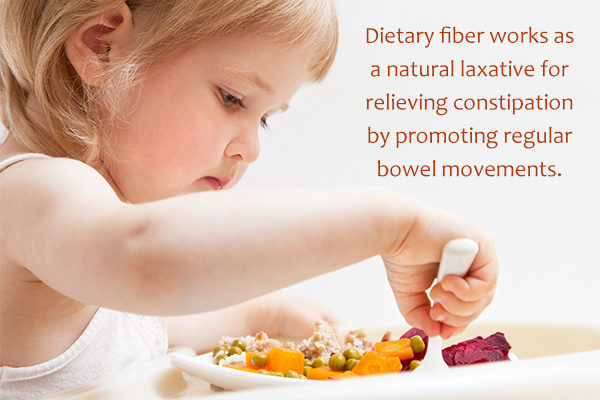In this article:
Constipation is one of the most commonly reported health complaints among children and is characterized by difficult, painful, infrequent, or incomplete bowel movements.

It often occurs due to behavioral tendencies, such as deliberately withholding bowel movements to avoid going to the loo because they are too busy playing or due to an aversion to new washrooms.
Changes in the diet, routine, or environment, child abuse, stress, medications, illnesses, and a variety of other factors can also hamper your child’s digestive functioning and induce constipation.
Home Remedies to Relieve Constipation
You can try these remedies along with the other lifestyle and dietary changes to relieve constipation in children.
1. Drink fruit juice (pear, white grape, and prune)
There are several fruit juices that contain a considerable amount of sorbitol, a hard-to-digest sugar that can promote bowel emptying.
Moreover, fruit juice is a healthy beverage that supplies water and nutrients to your digestive system. The extra water helps soften the hardened stools for easy excretion.
Top choices include the pear, white grape, and prune juice. It’s best to consume freshly squeezed fruit juices, rather than packaged ones which often contain harmful additives and excess sugar. The recommended intake is 4 ounces or less daily until your child starts having a regular bowel movement.
2. Give your child a gentle tummy rub
Stomach massages may act like laxatives as they can stimulate bowel movements. An abdominal massage is a safe option for constipation treatment as it has no side effects on the child’s health. (1)(2)
A gentle massage on the belly can help in relieving discomfort. Alternatively, rotating your child’s legs in a clockwise direction when he/she lies down on the back with legs flexed onto the belly may also be helpful.
Alternative Treatments
The following therapies can help ease constipation in children, provided they are done correctly.
1. Try acupuncture
Clinical trials have demonstrated the efficacy of acupuncture therapy in relieving constipation. (3)
Acupuncture has also been shown useful in the treatment of hospital-induced constipation in retrospective case studies. However, the effects are yet to be verified through randomized controlled trials. (4)(5)
Consult a pediatrician before considering acupuncture therapy for children. If the doctor gives you the go-ahead, always seek the expertise of a trained acupuncturist rather than trying this technique yourself.
2. OTC Miralax laxative
Laxatives are a class of medications that help soften hard stools to make them easier to pass. They work by restoring fluid to the dried up stool and are the go-to medication for relieving constipation. They are generally available as oral tablets, powders, or tonics, as well as rectal suppositories and enemas.
Constipation in newborn infants is usually treated with suppositories, but it’s safe to give oral laxatives to children older than 6 months.
Miralax is one of the most commonly used laxatives for children, which comes in the form of a tasteless, colorless powder that is easy for kids to stomach.
Although this laxative can be purchased without a prescription from any local pharmacy, it’s always better to consult your child’s doctor before starting the medication.
Dietary and Lifestyle Changes to Relieve Constipation
Fortunately, most cases of constipation are short-lived and can easily be treated with simple home interventions.
1. What to eat: High-fiber foods and probiotics

Fiber is a natural laxative and helps in treating constipation by softening the stool and promoting regular bowel movements. Include fiber-rich foods, such as whole-grain bread, beans, whole-grain cereals, as well as fruits and vegetables (preferably unpeeled) in your child’s diet. (6)
However, a sudden increase in fiber content may cause gas formation and bloating. Therefore, gradually increase your child’s fiber intake by no more than 5 grams a day. (7)
Constipation can be managed by adding Greek yogurt and other sources of probiotics in the child’s diet. Probiotics, or good bacteria, can help in the effective treatment of constipation as they increase the frequency of bowel movements. (8)
Foods that are rich sources of insoluble fiber and probiotics can help promote healthy digestion and smoother bowel movement when consumed as part of an overall healthy diet. However, a drastic increase in your fiber or probiotic intake can prove counterproductive, and therefore should be done gradually and within healthy limits.
2. What not to eat
The following foods can make your child increasingly constipated and therefore, should be avoided:
- Fast foods
- Meat
- Frozen meals
- Chips
- Processed foods such as hotdogs
- Microwavable dinners
- Rice cereal for some children
While bananas promote colon health, they may lead to constipation, especially in children. Unripe bananas are rich in tannins (100-250 mg/100 g banana) and amylase-resistant starch, which can aggravate or induce constipation. (9)
Ripe bananas contain soluble fibers (3 g/120 g banana), soluble sugars, and lesser amounts of tannins and amylase-resistant starch. Therefore, it is recommended to avoid giving bananas to constipated children. (9)
Constipation is often the result of poor food choices which lack fiber and are loaded with saturated or trans fats, complex carbs and other unhealthy elements instead that can overburden your child’s digestive system. Limiting the consumption of these unhealthy foods can help reduce the incidence of constipation.
3. Stick to a regular eating schedule
Persuade your child to have three proper meals in a day instead of snacking throughout the day. This ensures adequate appetite during meal time, enabling the child to eat more vegetables rather than snacking on cookies and crisps. A full stomach also facilitates proper bowel movement.
Children often create a fuss over food, which results in constipation. It is important to deal with your child patiently and bring a gradual change in their eating habits. Maintaining a record of your child’s food and liquid intake can help a medical professional in determining if the diet causes constipation.
Sticking to a proper eating schedule will help your child have regular bowel movements as opposed to erratic snacking which often leads to constipation.
4. Drink enough fluids
Dehydration is a common reason for pediatric constipation. Insufficient water levels in the body impede the functioning of the digestive system, resulting in the formation of dry and hard stool.
Moreover, you need water to wash down the dietary fiber through the gut. Only part of your fiber intake is ingested, while the rest adds bulk to the stool making it easier to pass through the intestines and out of the body. It does so by soaking in the water present in your digestive tract and turning into a gel-like substance that adds weight to your stool.
However, if there isn’t enough water in your system, the undigested fiber will remain stiff and make your stools hard, dry, and difficult to pass resulting in constipation. Thus, if you plan on increasing your fiber intake as a means to curb constipation, make sure to match it with a simultaneous increase in your daily fluid intake as well. (10)
Adequate intake of clear liquids, around 2 ounces per gram of fiber, is vital. You can give fluids to your child in the form of:
At times, children may try to refrain from drinking water. This problem can be overcome by using special cups or straws that look inviting or flavoring the water with lemon or cucumber.
Adequate fluid intake is key for proper digestion, and it needs to be adjusted according to your child’s activity level, overall health and more specifically his/her regular fiber intake. If you continue eating a lot of fiber without sufficient water consumption, you are likely to suffer more frequent bouts of constipation.
5. Keep your child physically active

Daily exercise is equally important for adults and children. Regular exercise helps in preventing obesity in children, releasing stored energy, teaching good habits, and maintaining healthy bowel movements. (13)
Physical activity facilitates a quick movement of food along the large intestine and helps in muscle contraction, leading to the expulsion of feces.
Staying active helps your body digest the food better and facilitates proper bowel movement, thereby reducing the incidence of constipation.
6. Fix a toilet routine
Kids often get constipated because they withhold their bowel movements when they are preoccupied, especially while playing. A fixed toilet habit helps your child develop the practice of routine defecation.
To train your child, try making them sit on the toilet after meals for 10 minutes each. Make sure that it is an enjoyable time for the child, and avoid getting agitated if he/she fails to make a bowel movement.
Using a footstool may provide leverage for easy excretion. If the child feels comfortable, accompany them while training.
Proper toilet training can help regularize your child’s bowel movement and make him/her understand the importance of using the loo when you feel the pressure rather than holding it in which often leads to constipation.
Final Word
A regular bowel pattern is a sign of a well-functioning digestive system, but occasional constipation in children is common and nothing to get worked up about. However, the problem can be a source of great discomfort, especially if it becomes a frequent occurrence.
The social aftermath of chronic constipation can have an adverse effect on the general health and well-being of children, and thus they require considerable parental support.
Diet modifications such as increasing water and fiber intake, exercise, and proper toilet training can help in alleviating most cases of chronic idiopathic constipation or functional constipation.
However, medical assistance may be needed if the problem does not respond to home treatment, becomes severely painful, or leads to blood in the stools, vomiting, or soiling.

- Was this article helpful?
- YES, THANKS!NOT REALLY


